Finding The Right PA System For You
Thinking of taking your act to the stage? Then you'll need a suitable way of amplifying it, and that all depends on what and where you're playing...
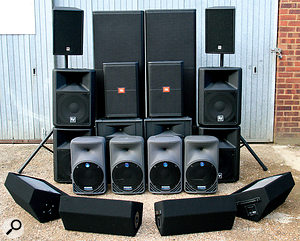
Most articles on PA systems start out by explaining how the various types of speaker cabinet work, but in this one I'm going to try to approach the subject from a different angle: looking at common types of act and venue, and then suggesting practical PA solutions for them.
These suggestions are based on the assumption that many of today's musicians travel by car rather than by van, and that they'd therefore like something as light and portable as possible that will still be able to do the job properly. Speaker systems have become more compact and more efficient over recent years, with the introduction of technologies such as switching mode power supplies and Class-D amplifiers. This means that active speakers can be made to weigh very little more than their passive equivalents, while still being more convenient to set up, as there's less need for cabling. There's another advantage to active systems, in that suitable speaker protection can be, and usually is, built in.
A further advantage is that if each speaker has its own amp, you can muddle along on one speaker if the other fails. However, some small systems are based around two satellite speakers and a sub, where all the power amps are in the sub — so if the sub electronics fail, you lose your entire PA. This happened to me once while playing a small pub, but happily we were able to utilise the powered monitors as a substitute PA to get through the evening — it pays to always have a backup plan!
Going Solo?
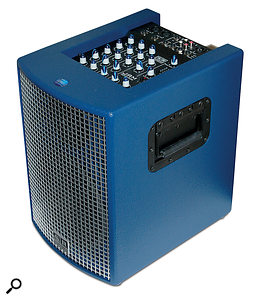
For smaller gigs, acoustic instrument amplifiers will often serve well as compact PA systems, as many of them incorporate simple mixer functionality and can accommodate both mic and instrument inputs.
Where the performer relies entirely on an instrument such as guitar or electric piano for accompaniment, rather than on backing tracks, a combo amp designed for acoustic guitar is often perfectly adequate for smaller venues. Unlike electric guitar amps, which are designed to impart their own sound, acoustic amps are essentially miniature PA systems, intended to simply amplify the signal going into them. They almost invariably offer an XLR mic input in addition to the instrument input, and so are ideal for singer/songwriter types. The speaker systems in such amps either use small full-range drivers or a driver teamed with a tweeter. They can all handle the vocal range perfectly adequately, and most also include some basic effects, such as reverb, making them good all-in-one solutions.
As long as they're not set up too high from the ground, combos can be used behind the performer at a reasonable level before feedback becomes a problem. The majority also include a pole-mount socket, facilitating mounting on a speaker stand.
I'd recommend a model of at least 70 Watts for small gigs, but do bear in mind that the amplifier power rating alone doesn't give an accurate indication of how loud the amplifier can go. The efficiency of the loudspeakers also plays a major part, so when you read the spec sheet, the SPL (Sound Pressure Level) is the most significant figure. To give you an idea of typical SPL figures, small combos are almost all capable of producing around 105dB (measured at one metre), but from a good full-size '12-inch plus horn' cabinet you could expect around 130dB, and sometimes even more.
Adding Up
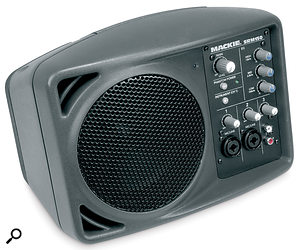
Compact, active PA cabinets can be put to good use as extension speakers to complement acoustic amps or small PA systems.
At larger venues, or those where a greater spread of sound is beneficial (those awkward L-shaped bars, for example), you can add an extension active speaker cabinet, as acoustic guitar amps usually include an XLR DI or link output, which can also be used to feed a large PA system at big gigs. A fairly small powered two-way cabinet (8- to 12-inch woofer plus horn) rated at anything from 100 Watts upwards will do the trick.
The Next Step
The human voice and the acoustic guitar don't usually produce low enough frequencies to require a great deal of bass extension, which is one reason why compact systems can produce great-sounding results. However, once you bring backing tracks, electronic keyboards or a full band with bass and drums into the equation, adequate bass handling becomes essential.
The solution you choose will depend on the range of venue sizes you tend to play. If you only play pubs, one of the smaller 'sub plus two satellites' systems may be the most appropriate, as these can still be compact enough to fit into a car, yet powerful enough to produce a satisfying musical experience. Good examples of this type of system include the smaller HK Lucas packages and LD Systems Dave setups. Because the sub takes over all the bass-handling duties, the satellite speakers can be made very compact — right down to shoe-box size — and even the sub itself might house only a single 10- or 12-inch speaker in the smaller systems. Most of these systems can produce a good stereo image even though there's only one sub, as very low frequencies are almost omnidirectional and it is difficult for the human hearing system to pinpoint the source.
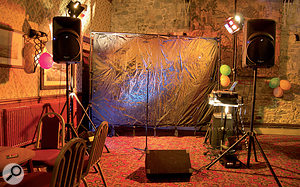
For smaller venues, and with simpler 'singer/songwriter' type acts, a basic two-speaker system without subwoofers may be all that's needed.
Because it's difficult to combine small size with high efficiency, and because it requires more power to achieve the same SPL at low frequencies as it does at high frequencies, I'd consider a system power of around 300 Watts to be a minimum for performers using backing tracks, or a mainly acoustic band playing the pub circuit. In such situations, acoustic feedback often sets the operating level threshold well below the PA system's actual handling capacity. Just be aware that if there are bass instruments that need amplifying, you'll need a more powerful sub. See also the 'Line Arrays' box, as the smaller line-array systems lend themselves to anything from solo performers, duos and acoustic acts to rock bands playing pubs and smaller clubs — and most can be expanded for use in larger venues.
If you're not ready to embrace the line-array approach (and a decent line array can still be quite expensive to a band on a budget), there's plenty of mileage left in conventional 12-inch-plus-horn active speakers. These can be used on their own where the primary purpose is to carry vocals, acoustic guitars and so on, or in conjunction with a sub where bass instruments and kick drums need a little help. In theory, many of these so-called full-range boxes boast a frequency response of down to 50Hz or so, but the bass sound from such a box is seldom good and bass frequencies eat up so much headroom that the overall system level will be severely compromised. In other words, if you need to amplify bass, add appropriate subs, don't thrash your main speakers. Both active and passive subs typically include crossovers that reduce the amount of low end reaching the main speakers, allowing the latter to give of their best in the vocal range and above.
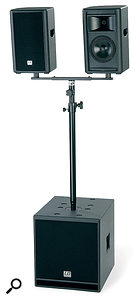
Sub-and-top PA systems can be made extremely portable, and they have the advantage that you can take only the elements of the system that you need for each gig.
While plastic speaker boxes, such as the popular Mackie SRM and JBL Eon models, are resilient and adequately loud, many of the cheaper (and some of the less cheap) plastic boxes can sound a little resonant and blurred in the lower mid-range when heard alongside a good plywood or MDF cabinet. Although wooden cabinets are often a little larger, their flat, straight sides can also make them easier to stack in a car. Whether you go for wood or plastic, however, one factor that is common to all of them is that the bigger the main driver, the more difficult it is for the designers to get the frequency ranges of the woofer and HF horn to meet properly in the middle. Ten-inch woofers have limited power handling but tend to team well with a horn, and the same is true of a well-designed 12-inch system. But once you get up to 15-inch, only the better designers seem to pull the trick off successfully, and the crossover frequency tends to fall right in the middle of the vocal range, so if it isn't done right you won't get a natural vocal sound.
A couple of decent 12-inch main speakers ('tops') teamed with one or two 15-inch or 18-inch subs will tackle just about any situation, from the local pub to a beer festival, and you have some limited scalability in that you can take just one sub for smaller gigs and both for larger ones, or in very small pubs you may not want to put the bass or kick drum through the PA at all, so you can leave the subs at home.
If you play a variety of venue sizes, it makes sense to buy a scalable system, where you can take only the components that are needed to do the job, rather than hauling the entire system around with you everywhere. For example, two smaller subwoofers may be more practical than one large one in this respect, as you can leave one or both behind when needs dictate. You can also add more top cabinets when you graduate to larger venues, although in my experience there are few venues requiring larger systems that don't have their own in-house PAs.
False Economies
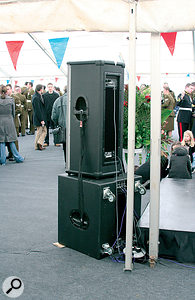
Where more volume is needed, especially if you need to put bass or drums through the PA, a subwoofer is pretty much essential.
There are systems to cover every venue size and every budget but, as in most areas, you get what you pay for. In the world of PA, this tends to mean that spending more money not only gets you a better sound, it also gives you something more compact and portable. A high-end system might seem expensive, but it probably takes up less than half the space of a comparable system built using cheaper components, and most likely still sounds noticeably better. Spending a little more on the PA itself might mean that you can do away with the need for a van and take all your gear in cars, so factor these savings into the price.
Seemingly compact systems — such as the little line arrays I've mentioned — can, if well designed, fill surprisingly large venues, often carrying to the back of the room better than conventional box systems. They can be made so compact because all the heavy work is offloaded to the sub, leaving the relatively small mid-range/high-frequency units to carry the less burdensome part of the audio spectrum. Modern drivers are also more efficient than those of last generation, while Class-D amps pack an enormous amount of power into a much smaller and lighter package than is possible with a conventional analogue amplifier, so good doesn't have to mean heavy. A quality system will last a great many years, so it pays to choose carefully and to buy the very best you can afford.
https://www.soundonsound.com/sound-advice/finding-right-pa-system-you